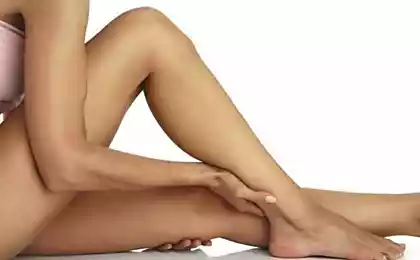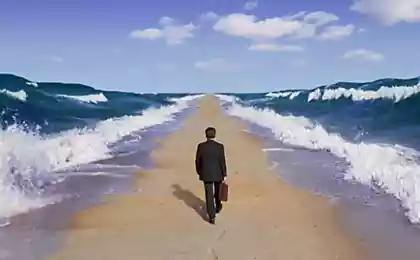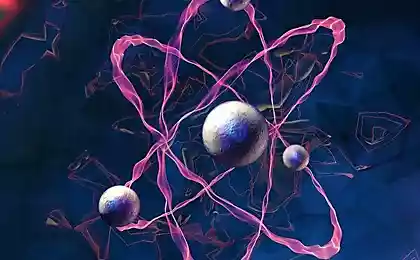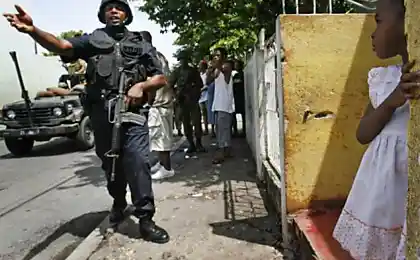1000
100 days of curiosity
November 16 - a symbolic date for the Mars Exploration Program. The largest and most modern rover MSL Curiosity spent on the surface of the fourth planet 100 Martian days - Soloviev. Sol longer than Earth days only 40 minutes, so the difference with a small earthly time. 100 days to sum preliminary results, which we will try to do.
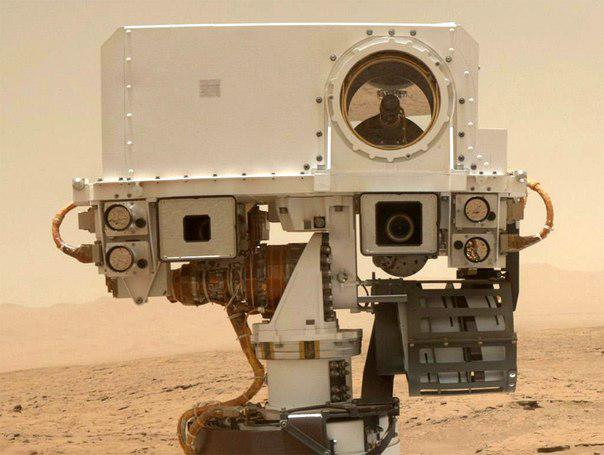
Today, our knowledge of Mars are based largely on data collected from orbit over the past ten years there working three US satellite, a European and a few were passing by. Land Rovers, despite their heroic efforts and a record not produced such a revolution, such as landline Phoenix Lander, which is a few strokes of his bucket put an end to the issue of whether there is water on Mars.

But the Phoenix have imposed a satellite - go there, where there should have been water. Similarly, Opportunity is now looking for an ancient clay where have satellite.
That is, most of our knowledge about Mars was obtained remotely.

Now, mankind needed to refine and structure their knowledge. To this end, the mission was assembled MSL. I say "humanity" and not "America" because Curiosity was collected in a way the whole world. Alpha radiation X-ray spectrometer made (and paid $ 17 million.) Canadians. The laser and camera ChemCam - French. Climate sensor REMS - Spaniards. Roskosmos contributed to a neutron detector DAN, who is looking at the water = hydrogen rover. Australians and Spaniards provide their radar to maintain a connection with the rover when the rotation of the earth covers the US Mars (Mars rotation limiting direct communication sessions to 16 hours). In short, if anyone has information that the rover rolls in the Mexican desert, please contact us here: www.federalspace.ru/main. php? id = 7

To get the maximum information from the surface of Mars, taken a very careful approach to the choice of the landing site. Even the powerful and large rover can explore the entire planet, whose area is almost equal to the land area on Earth. We had to choose a place in geologically promising to investigate the evolution of the planet throughout its history and in all periods. An important place is given to the search for evidence of the epoch on Mars climate conducive to the emergence and development of life. In addition, it was necessary to adjust to the technical capabilities of the system and the landing of the Mars rover. For example, all the geological layers certainly can be found in the walls of Valles Marineris, but the rover will not be able to climb vertical slopes of several kilometers, so this place is eliminated. For the descent capsule and parachute air density is important, so that place more than 1 km away from the average level also fall away - no time to slow down. Therefore, out of 30 possible options, first took 4 most "delicious", and then stopped at the crater Gale.

Gale Crater is interesting for its mountain Sharpe as NASA calls or Eolidoy, insists the International Astronomical Union. Some would-be Russian expert wondered why Curiosity uphill climb, it's not the same for mountaineering successes flew. But if you look closer, the mountain - a layer cake older than 3 billion. Years of layers of different periods. Thus, in ancient times, the cake was carefully cut the flow of water, which has provided a convenient ramp for lifting up and consistent examination of all layers. This study, with the scientific arsenal that carries on itself Curiosity, is to give an amount of knowledge which can be compared at all with all the knowledge about Mars, accumulated so far.
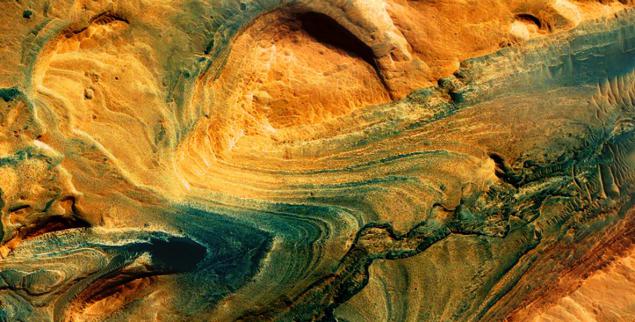
But 100 days have passed, but the revolution has not yet heard. Yes, the rover found traces of water flow, examined the curious stone, made a bow at the mountain. Can I call it revolutionary results?
Try to understand.
To begin with, what actually to Mount Curiosity has not yet been reached. Prior to the planned place of the ascent - about eight kilometers, and until he was 450 m. Thus, the main stream of scientific data will start well if c mid-2013. The main thing, which was completed in 100 days - a tested and tried in fact, almost all of the tools and instruments of the rover. Excluding leaves only a drill, but also to reach a deal soon.
Tell us more about its arsenal and the first results.

Color Camera Curiosity, from the point of view of NASA - is a research tool, and is not a means for entertainment taxpayers. James Cameron has made efforts to fly two identical cameras with zoom lens. This would remove the "Avatar 2" on Mars. And NASA even went to meet him - cameras have been ordered and almost made, but in terms no longer fit, so fly scheduled earlier cameras, two megapixel Mast Cam with a fixed focal length of a 34-second 100 mm. Accordingly, the first to cover a wider viewing angle, and the second - see further. Although if you want out of their frames and you can make good anaglyphs

Left 34mm camera has been tested on the third day after landing - she shot a panorama of the same color to the delight of the audience. In the second there were some problems. During the first weeks, she worked would send black and white pictures and I realized they were not the purpose of NASA. Then everything will work out and now she snaps, still almost every day.

Color camera MAHLI was involved immediately. It is located on the robot arm and hand rover developed already after a few hundred meters traveled. And the first test shots, it makes it even through dust filter. Unlike other cameras there is not a one-off cap, but a real door.
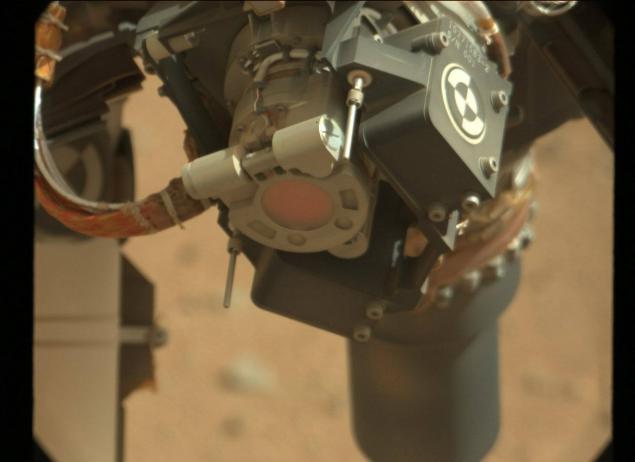
The picture quality is simply amazing: shows details of a fraction of a millimeter, and can act as a microscope. She often makes stereoscopic photographs from which to make anaglyphs, and takes in the infra-red light.
(a stone, a strange light from the LED backlight)

Laser ChemCam was quickly put into the case and is now working without rozdyha. Point data scientists are now few, they fire bursts, not saving ammunition. However, according to the specifications on the RTGs, "cartridges" for the laser should be sufficient for 14 years. The laser heats the target to the plasma state, the camera-telescope ChemCam captures light flashes and a spectrometer determines the composition of luminous matter.
(vertical stripe - from laser "line»)

It should be said about the quality of the photos ChemCam. The idea to use a reflecting telescope for the macro not the most successful, especially without the flash. But, first, a metal plate mirror meets the high reliability requirements of the rover, and secondly, the camera copes with its scientific purpose: aiming to 7 meters and delivering light in a plasma spectrograph.
These devices are in the "first tier" - they meet the scientific mysteries from afar. Manual for the rover are taken by the instrument APXS (alpha-ray spectrometer rays).

Such devices have been in all since the rover Sojourner, but Curiosity He is perfect, so conducting tests several times faster than its predecessors. The unit is located on the keypad, it is pressed against the sample, irradiates its alpha-rays, he begins to emit X-ray emission spectrum and analyzes the spectrometer. ChemCam and APXS were tested in a pair on the rock "Jake Matievich" and revealed its volcanic origin.
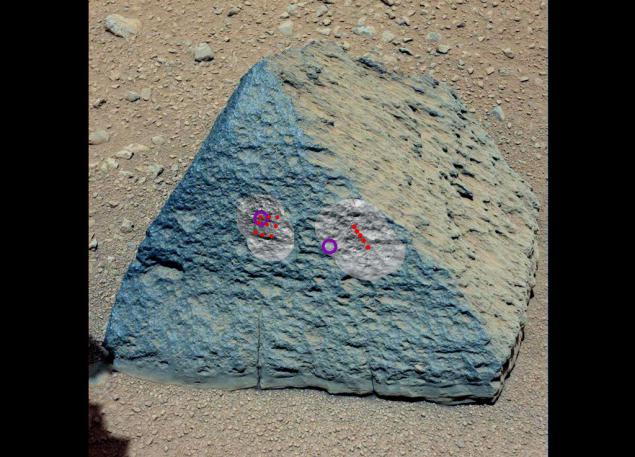
External devices are not limited to geological rover. Climate sensor REMS and radiation RAD collect information about the external physical conditions. RAD directly stated as a device that collects information for future manned expedition to Mars.

At the beginning of the expedition revealed the first failure - denied one of two wind sensors. For this reason, Curiosity problems with the definition of the direction of air flow. Besides wind sensors REMS includes a temperature sensor, surface temperature and atmospheric pressure. Daily weather reports from Mars are available here: cab.inta-csic.es
At devices provide interesting information about how changing atmospheric pressure, air temperature and soil during the day and longer periods of time.

Just today, we showed an interesting moment, caught instruments: a few seconds pressure plummeted, while wind gust was recorded. NASA experts have determined that it happened when the rover collided small tornado - dust devil, who repeatedly watched the previous machines, even the satellites, but had never seen Curiosity.
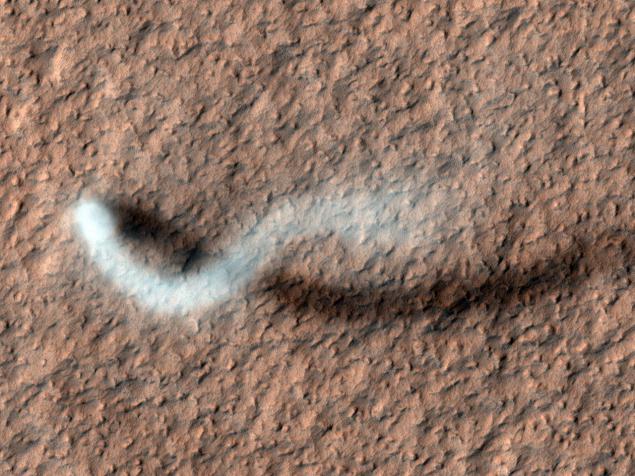
An interesting observation was made 60 Sols, atmospheric pressure sensor. Although the dynamics of daily fluctuations in that time has not changed, the absolute figure has increased pressure. This is the result of changes in the spring - warm weather causes increased evaporation of carbon dioxide in the southern polar cap, and the total volume of the atmosphere increases, and with it the pressure on the entire planet.
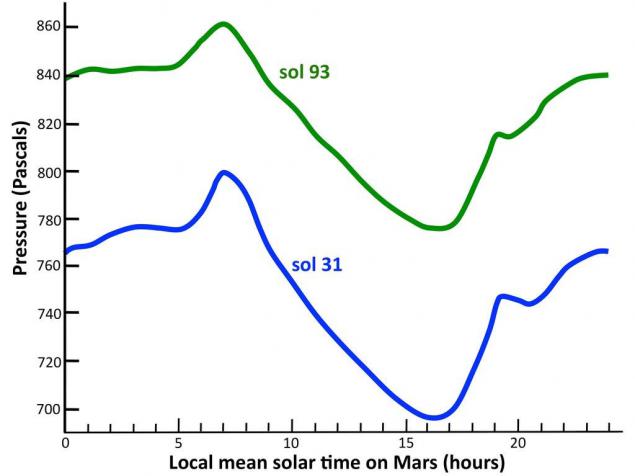
The radiation detector RAD's record all types of ionizing radiation, which can only come down on the Martian surface from space. In fact - this is not just a dosimeter and radiation telescope. He revealed other interesting details.

The volume of radiation during the day naturally vary depending on the position of the sun relative to the Martian surface. Happy increase in intensity reduction at night. But on record managed to fix the periods of 27 days. They reflect the daily rotation of the Sun, ie, different parts of the solar surface radiate with different intensities. Of course, the scientists this is not news, but to see this dynamic Mars - is in itself unusual.

Russian DAN detector was working during the entire path of the rover. However, the results are released only for the first few days - according to Russian experts the water at the landing site was "no more than a concrete floor." But, apparently, it is not just about talking. Now Curiosity lingered on the edge of the lowlands, which probably was once a body of water - at the bottom can be more than hydrated materials and DAN please discoveries.

We checked in and the two most promising and the most perfect instrument: CheMin - chemical and mineralogical tools and SAM - the unit of analysis of Martian samples. Both of them are located within the body of the rover and sample loading manipulator. CheMin accurately determine the mineral composition of the sample under study, study its crystal lattice and chemical composition. Trial results of its work has been made public, and recently it downloaded the following sample, however, the same pile of sand.
SAM - it's all an incredible tool for its size. The box the size of a microwave oven includes a quadrupole mass spectrometer, gas chromatograph, and tunable laser spectrometer. The main task of SAM - a search for "building blocks of life" - hydrocarbon compounds, which are precursors of life, past or present.

All three devices are exploring atmospheres, so SAM exploring all gaseous and not a gas it is heated to 1000 ° C and is studying how gaseous. Yes, there is also a stove. SAM determines the atomic weight of the substance, measures the isotopic content and determines the chemical composition. This unique device requires a separate story. He has studied the Martian air and went to the ground. All this construction absorbs almost all available energy rover, so now be sent very few pictures - Curiosity Mars fries.
As a result, for the 100 days we have learned that the first goal of the mission accomplished - the rover on the surface of all the major systems are working properly, the machine is a beast, and Mars should be studied!
© Habrahabr
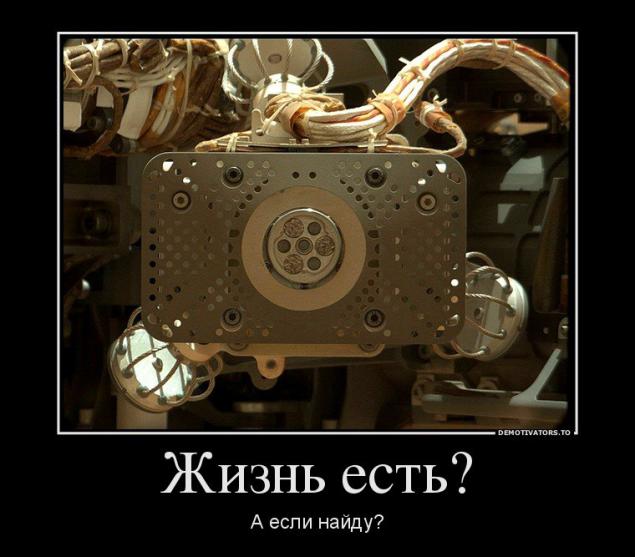
Source:

Today, our knowledge of Mars are based largely on data collected from orbit over the past ten years there working three US satellite, a European and a few were passing by. Land Rovers, despite their heroic efforts and a record not produced such a revolution, such as landline Phoenix Lander, which is a few strokes of his bucket put an end to the issue of whether there is water on Mars.

But the Phoenix have imposed a satellite - go there, where there should have been water. Similarly, Opportunity is now looking for an ancient clay where have satellite.
That is, most of our knowledge about Mars was obtained remotely.

Now, mankind needed to refine and structure their knowledge. To this end, the mission was assembled MSL. I say "humanity" and not "America" because Curiosity was collected in a way the whole world. Alpha radiation X-ray spectrometer made (and paid $ 17 million.) Canadians. The laser and camera ChemCam - French. Climate sensor REMS - Spaniards. Roskosmos contributed to a neutron detector DAN, who is looking at the water = hydrogen rover. Australians and Spaniards provide their radar to maintain a connection with the rover when the rotation of the earth covers the US Mars (Mars rotation limiting direct communication sessions to 16 hours). In short, if anyone has information that the rover rolls in the Mexican desert, please contact us here: www.federalspace.ru/main. php? id = 7

To get the maximum information from the surface of Mars, taken a very careful approach to the choice of the landing site. Even the powerful and large rover can explore the entire planet, whose area is almost equal to the land area on Earth. We had to choose a place in geologically promising to investigate the evolution of the planet throughout its history and in all periods. An important place is given to the search for evidence of the epoch on Mars climate conducive to the emergence and development of life. In addition, it was necessary to adjust to the technical capabilities of the system and the landing of the Mars rover. For example, all the geological layers certainly can be found in the walls of Valles Marineris, but the rover will not be able to climb vertical slopes of several kilometers, so this place is eliminated. For the descent capsule and parachute air density is important, so that place more than 1 km away from the average level also fall away - no time to slow down. Therefore, out of 30 possible options, first took 4 most "delicious", and then stopped at the crater Gale.

Gale Crater is interesting for its mountain Sharpe as NASA calls or Eolidoy, insists the International Astronomical Union. Some would-be Russian expert wondered why Curiosity uphill climb, it's not the same for mountaineering successes flew. But if you look closer, the mountain - a layer cake older than 3 billion. Years of layers of different periods. Thus, in ancient times, the cake was carefully cut the flow of water, which has provided a convenient ramp for lifting up and consistent examination of all layers. This study, with the scientific arsenal that carries on itself Curiosity, is to give an amount of knowledge which can be compared at all with all the knowledge about Mars, accumulated so far.

But 100 days have passed, but the revolution has not yet heard. Yes, the rover found traces of water flow, examined the curious stone, made a bow at the mountain. Can I call it revolutionary results?
Try to understand.
To begin with, what actually to Mount Curiosity has not yet been reached. Prior to the planned place of the ascent - about eight kilometers, and until he was 450 m. Thus, the main stream of scientific data will start well if c mid-2013. The main thing, which was completed in 100 days - a tested and tried in fact, almost all of the tools and instruments of the rover. Excluding leaves only a drill, but also to reach a deal soon.
Tell us more about its arsenal and the first results.

Color Camera Curiosity, from the point of view of NASA - is a research tool, and is not a means for entertainment taxpayers. James Cameron has made efforts to fly two identical cameras with zoom lens. This would remove the "Avatar 2" on Mars. And NASA even went to meet him - cameras have been ordered and almost made, but in terms no longer fit, so fly scheduled earlier cameras, two megapixel Mast Cam with a fixed focal length of a 34-second 100 mm. Accordingly, the first to cover a wider viewing angle, and the second - see further. Although if you want out of their frames and you can make good anaglyphs

Left 34mm camera has been tested on the third day after landing - she shot a panorama of the same color to the delight of the audience. In the second there were some problems. During the first weeks, she worked would send black and white pictures and I realized they were not the purpose of NASA. Then everything will work out and now she snaps, still almost every day.

Color camera MAHLI was involved immediately. It is located on the robot arm and hand rover developed already after a few hundred meters traveled. And the first test shots, it makes it even through dust filter. Unlike other cameras there is not a one-off cap, but a real door.

The picture quality is simply amazing: shows details of a fraction of a millimeter, and can act as a microscope. She often makes stereoscopic photographs from which to make anaglyphs, and takes in the infra-red light.
(a stone, a strange light from the LED backlight)

Laser ChemCam was quickly put into the case and is now working without rozdyha. Point data scientists are now few, they fire bursts, not saving ammunition. However, according to the specifications on the RTGs, "cartridges" for the laser should be sufficient for 14 years. The laser heats the target to the plasma state, the camera-telescope ChemCam captures light flashes and a spectrometer determines the composition of luminous matter.
(vertical stripe - from laser "line»)

It should be said about the quality of the photos ChemCam. The idea to use a reflecting telescope for the macro not the most successful, especially without the flash. But, first, a metal plate mirror meets the high reliability requirements of the rover, and secondly, the camera copes with its scientific purpose: aiming to 7 meters and delivering light in a plasma spectrograph.
These devices are in the "first tier" - they meet the scientific mysteries from afar. Manual for the rover are taken by the instrument APXS (alpha-ray spectrometer rays).

Such devices have been in all since the rover Sojourner, but Curiosity He is perfect, so conducting tests several times faster than its predecessors. The unit is located on the keypad, it is pressed against the sample, irradiates its alpha-rays, he begins to emit X-ray emission spectrum and analyzes the spectrometer. ChemCam and APXS were tested in a pair on the rock "Jake Matievich" and revealed its volcanic origin.

External devices are not limited to geological rover. Climate sensor REMS and radiation RAD collect information about the external physical conditions. RAD directly stated as a device that collects information for future manned expedition to Mars.

At the beginning of the expedition revealed the first failure - denied one of two wind sensors. For this reason, Curiosity problems with the definition of the direction of air flow. Besides wind sensors REMS includes a temperature sensor, surface temperature and atmospheric pressure. Daily weather reports from Mars are available here: cab.inta-csic.es
At devices provide interesting information about how changing atmospheric pressure, air temperature and soil during the day and longer periods of time.

Just today, we showed an interesting moment, caught instruments: a few seconds pressure plummeted, while wind gust was recorded. NASA experts have determined that it happened when the rover collided small tornado - dust devil, who repeatedly watched the previous machines, even the satellites, but had never seen Curiosity.

An interesting observation was made 60 Sols, atmospheric pressure sensor. Although the dynamics of daily fluctuations in that time has not changed, the absolute figure has increased pressure. This is the result of changes in the spring - warm weather causes increased evaporation of carbon dioxide in the southern polar cap, and the total volume of the atmosphere increases, and with it the pressure on the entire planet.

The radiation detector RAD's record all types of ionizing radiation, which can only come down on the Martian surface from space. In fact - this is not just a dosimeter and radiation telescope. He revealed other interesting details.

The volume of radiation during the day naturally vary depending on the position of the sun relative to the Martian surface. Happy increase in intensity reduction at night. But on record managed to fix the periods of 27 days. They reflect the daily rotation of the Sun, ie, different parts of the solar surface radiate with different intensities. Of course, the scientists this is not news, but to see this dynamic Mars - is in itself unusual.

Russian DAN detector was working during the entire path of the rover. However, the results are released only for the first few days - according to Russian experts the water at the landing site was "no more than a concrete floor." But, apparently, it is not just about talking. Now Curiosity lingered on the edge of the lowlands, which probably was once a body of water - at the bottom can be more than hydrated materials and DAN please discoveries.

We checked in and the two most promising and the most perfect instrument: CheMin - chemical and mineralogical tools and SAM - the unit of analysis of Martian samples. Both of them are located within the body of the rover and sample loading manipulator. CheMin accurately determine the mineral composition of the sample under study, study its crystal lattice and chemical composition. Trial results of its work has been made public, and recently it downloaded the following sample, however, the same pile of sand.
SAM - it's all an incredible tool for its size. The box the size of a microwave oven includes a quadrupole mass spectrometer, gas chromatograph, and tunable laser spectrometer. The main task of SAM - a search for "building blocks of life" - hydrocarbon compounds, which are precursors of life, past or present.

All three devices are exploring atmospheres, so SAM exploring all gaseous and not a gas it is heated to 1000 ° C and is studying how gaseous. Yes, there is also a stove. SAM determines the atomic weight of the substance, measures the isotopic content and determines the chemical composition. This unique device requires a separate story. He has studied the Martian air and went to the ground. All this construction absorbs almost all available energy rover, so now be sent very few pictures - Curiosity Mars fries.
As a result, for the 100 days we have learned that the first goal of the mission accomplished - the rover on the surface of all the major systems are working properly, the machine is a beast, and Mars should be studied!
© Habrahabr

Source:










